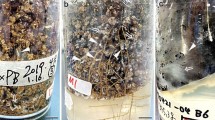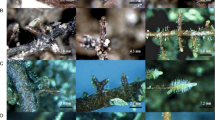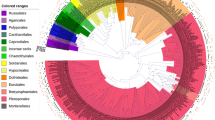Abstract
The effects of medium, pH, water potential and temperature on the culture for three pure strains (Lactarius deliciosus, Boletus edulis and Lactarius insulsus) of ectomycorrhizal fungi from plantation forests of Mongolian pine (Pinus sylvestris var. mongolica) on sandy lands were observed to obtain the optimum conditions for the growth of ectomycorrhizal fungi. The results indicated that the three ectomycorrhizal fungi could grow well in the mediums containing natural components, such as vitamin, pine juice and yeast powder. pH had a slight effect on the growth of the three ectomycorrhizal fungi, and the optimum pH values were 6.0 for L. deliciosus, 5.0 for B. edulis, respectively. However, L. insulsus had a wide pH range, and it grew better than the other two strains in neutral and light alkalescent mediums. Water potential (produced by Polyethylene Glycol, PEG) had significant effects on the ecological adaptability for the tested three fungi strains. All of the three stains grow better at lower PEG concentration (100 g PEG·kg−1 H2O). The best water potential was 10% PEG concentration for all of the three stains. Temperatures, especially high temperatures induced the fungi death. The optimum temperature for the growth of ectomycorrhizal fungi was 25–28°C for all of the three stains.
Similar content being viewed by others
References
Ahonen-Jonnarth U. 2000. Growth, nutrient uptake and ectomycorrhizal function in Pinus sylvestris plants exposed to aluminium and heavy metals. Doctoral Thesis. Swedish University of Agricultural Sciences. SLU Service/ Repro, Uppsala. ISBN 91-576-5864-1.
Allen MF. 1991. The Ecology of Mycorrhizae. Cambridge: Cambridge University Press,.
Baar J, Comini B, Elferink MO, Kuyper TW. 1997. Performance of four ectomycorrhizal fungi on organic and inorganic nitrogen sources. Mycol Res, 101: 523–529.
Bi Guochang, Guo Xiuzhen. 1989. Influence of temperature on colony growth of ectomycorrhizal fungi in pure culture. For Res, 3: 247–253. (in Chinese)
Byrd KB, Thomas Parker V, Vogler DR, Cullings KW. 2000. The influence of clear-cutting on ectomycorrhizal fungus diversity in a lodgepole pine (Pinus contorta) stand, Yellostone National Park, Wyoming, and Gallatin National Forest, Montana. Canadian Journal of Botany, 78: 149–156.
Chen GS, Zeng DH, Chen FS. 2004. Concentrations of foliar and surface soil in nutrients Pinus spp. Plantations in relation to species and stand age in Zhanggutai sandy land, northeast China. Journal of Forestry Research, 15:11–18.
Giltrap NJ, Lewis DH. 1981. Inhibition of growth of ectomycorrhizal fungi in culture by phosphate. New Phytol, 87: 669–675.
Gregory K, Eaton. 2002. Plasticity and constraint in growth and protein mineralization of ectomycorrhizal fungi under simulated nitrogen deposition. Mycologia, 94: 921–932.
Griffin DM. 1978. Effect of soil moisture on survival and spread of pathogens. In: Kozlowski T. T. (Ed.), Water deficits and Plant growth Vol. 5. New York: Academic Press, 175–197.
Guo Xiuzhen, Bi Guochang. 1989. Forest Mycorrhiza and Its Applied Technology. Beijing: China Forestry Publishing House, 43–62.(in Chinese)
Han Guiyun, Liu Chen, Zhou Yuzhi. 1993. Effect of temperature and pH on mycorrhizal fungus growth. Chin J Ecol, 12: 15–19. (in Chinese)
Hung, L, Trappe JM. 1983. Growth variation between and within species of ectomycorrhizal fungi in reaponse to pH in vitro. Mycologia, 75: 234–241.
Jefferies RL, Maron JL. 1997. The embarrassment of riches: atmospheric deposition of nitrogen and community and ecosystem processes. Trends Ecol Evol, 12: 74–78.
Johansson JF. 2002. Belowground ectomycorrhizal community structure along a local nutrient gradient in a boreal forest in Northern Sweden. Swedish University of Africultural Sciences, Uppsala 1–26.
Jonbloed RH, Borst-pauwels GWFH. 1990. Effect of ammonium and pH on growth of some ectomycorrhizal fungi in vitro. Acta Bot Neerl., 39:349–358.
Kaufmann MR, Eckard AN. 1971. Evaluation of water stress control with polyethylene glycols by analysis of guttation. Plant physiol., 47: 453–456.
Machado H, Braganca H. 1996. In vitro study of ectomycorrhiza formation under drought stress conditions. In: Mycorrhizas in integrated systems from genes to plant development (Proceedings of the fourth European symposium on mycorrhizas), pp455–458.
Marx DH. 1969. The influence of ectotrophic mycorrhizal fungi on the resistance of pine roots to pathogenic infections. I. Antagonism of mycorrhizal fungi to root pathogenic fungi and soil bacteria. Phytopathology, 59:153–163.
Marx DH, Daniel WJ. 1976. Maintaining cultures of ectocycorrhizal an plant pathogenic fungi in sterile water cold storage. Canad J Microbiol, 22:338–341.
Mexa J, Reid CPP. 1973. The growth of selected mycorrhizal fungi in response to induced water stress. Canad J Bot, 51: 1579–1588.
Michel BE. 1971. Further comparisons between Carbowax 6000 and mannitol as suppressants of cucumber hypocotyls elongation. Plant physiol, 48:513–516.
Nazar RN., Robb, EJ. and Volossiouk, T. 1996. Direct extraction of fungal DNA from soil. In: Akkermans, A. D. L., van Elsas, J. D., de Bruijn), F.J. (Eds.), Molecular Microbial Ecology Manual 1.3.6. Kluwer, Dordrecht, 1–8.
Sánchez F., Honrubia M, Torres P. 2001. Effects of pH, water stress and temperature on in vitro cultures of ectomycorrhizal fungi from Mediterranean forests. Cryptogamie Mycol, 22: 243–258.
Smith SE, Read DJ. 1997. Mycorrhizal symbiosis. 2nd edition. Academic Press, New York. pp605.
Theodorou C. 1971. Influence of temperature on the mycorrhizal association of Pinus rodiota. Aust J Bot, 19: 13–20.
Wang H, Dai LM, Yang BS, Lang QL, Gu HY. 2005. Occurrence and culture of mycorrhizal fungi associated with oaks in Dandong region, Liaoning province. Pedosphere, 15: 232–237.
Wu Bingyu. 1991. Mycorrhiza and water stress. J Beijing For Univ, 13:95–104. (in Chinese)
Wu Xiangyun., Liu Guang, Han Hui. 2002. Soil quality in the different types of Pinus sylvestris var. mongolica man-made sand-fixation forest. J Beihua Univ (Natural Science), 3: 76–79. (in Chinese)
Xu Meiling, Zhu Jiaojun, Sun Junde, Kang Hongzhang, Xu Hui. Zhang Huiwen. 2004. A review on the relationships between forest ectomycorrhizal fungi and environmental factors. Chin J Ecol, 23: 212–217. (in Chinese)
Zhao Zhipeng, Guo Xiuzhen. 1989. Ecological studies on ectomycorrhizal fungi in pure cultures. For Res, 2: 136–141. (in Chinese)
Zhang Zhenghe, Zheng Weipeng, Yi Keer, Li Jiahe, Chen Xuejiao. 1996. A study on ecology of Russula Vinose. Acta Ecol Sinica. 16: 208–210. (in Chinese)
Zhou Chonglian, Han Guizhi, Zhou, Yuzhi, Liu Chen, Zhang Weichun, Xu Guanghui. 1983. The research of some ectomycorrhizal fungi of pine. Acta Ecol Sinica, 2: 103–109. (in Chinese)
Zhu Jiaojun, Xu Hui, Xu Meiling, Kang Hongzhang. 2003. Review on the ecological relationships between forest trees and ectomycorrhizal fungi. Chin J Ecol, 22: 70–76. (in Chinese)
Zhu JJ, Fan ZP, Zeng DH, Matsuzaki, T. 2003. Comparison of stand structure and growth between plantation and natural forests of Pinus sylvestris var. mongolica on sandy land. Journal of Forestry Research, 14: 103–111.
Zhu Jiaojun., Li Zhihui, Kang Hongzhang,. 2005. Effect of polyethylene glycol(PEG)-simulated drought stress on Pinus sylvestris var. mongolica seed germination on sandy land. Chin J Appl Ecol, 16: 801–804. (in Chinese)
Author information
Authors and Affiliations
Corresponding author
Additional information
Foundation project: The research was supported by Major Knowledge Innovation Program of Chinese Academy Sciences (KZCX1-YW-08-02) and the 100-Young-Researcher-Project of Chinese Academy of Sciences.
Rights and permissions
About this article
Cite this article
Xu, Ml., Zhu, Jj., Kang, Hz. et al. Optimum conditions for pure culture of major ectomycorrhizal fungi obtained from Pinus sylvestris var. mongolica plantations in southeastern Keerqin sandy lands, China. Journal of Forestry Research 19, 113–118 (2008). https://doi.org/10.1007/s11676-008-0019-2
Received:
Accepted:
Published:
Issue Date:
DOI: https://doi.org/10.1007/s11676-008-0019-2




